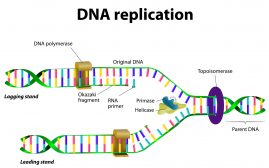Table of Contents
Definition
noun
plural: adenines
ad·e·nine, ˈædɪnɪn
(biochemistry) A purine nucleobase that complementary pairs with thymine in DNA and with uracil in RNA, and has a chemical formula of C5H5N5
Details
Overview
Nucleic acids such as DNA and RNA are polymers of monomeric nucleotides. Each nucleotide is made up of phosphoric acid, sugar (5-carbon), and nitrogenous base (or nucleobase). There are five nucleobases that serve as fundamental units of the genetic code: (1) adenine, (2) guanine, (3) cytosine, (4) thymine, and (5) uracil. These nitrogenous bases may be classified into purines and pyrimidines.
Properties
Adenine is a purine nucleobase with a chemical formula of C5H5N5. Purines are heterocyclic aromatic organic compounds. As a purine, adenine is comprised of two carbon rings: a pyrimidine ring and an imidazole ring. When it is a constituent of DNA, it is linked to the deoxyribose sugar by a covalent bond, and is referred to as adenine residue.
Adenine vs. Guanine
Guanine is another purine nucleobase. Adenine can be distinguished from guanine by its amine group at position 6 and the presence of an additional double bond between N-1 and C-6 in its heterocyclic aromatic (pyrimidine) ring. While guanine complementary pairs with cytosine in both DNA and RNA molecules, adenine complementary pairs with thymine in DNA and with uracil in RNA. Adenine is linked to either thymine or uracil by two hydrogen bonds.
Common biological reactions
Common biological reactions
Adenine, similar to guanine, is derived from the nucleotide inosine monophosphate (IMP) since purines are synthesized as ribonucleotides and not as free nucleobases. IMP, in turn, is produced from a pre-existing ribose phosphate that forms mainly from the amino acids glycine, glutamine, and aspartic acid. Ribose 5-phosphate reacts with ATP to produce 5-Phosphoribosyl-1-pyrophosphate (PRPP). PRRP has a role in both purine and pyrimidine synthesis; it is also involved in NAD and NADP formation and salvage pathways. PRRP though becomes committed particularly to purine biosynthesis when PRRP is converted into 5-phosphoribosyl amine by having the pyrophosphate of PRRP replaced by the amide group of glutamine. In humans, the biosynthesis of purines occurs in the cytosol of the liver cell. IMP is then converted into either adenosine monophosphate (AMP) or guanosine monophosphate (GMP). Guanosine triphosphate (GTP) provides energy for the conversion of IMP to AMP.
Common biological reactions
Adenosine and deoxyadenosine are the nucleosides of adenine. The adenosine (i.e. an adenine bound to a ribose sugar) that is phosphorylated with three phosphoric acid groups becomes adenosine triphosphate (ATP). ATPs are energy-rich molecules that serve as an energy source for various metabolic activities. Some of the ways by which ATPs are produced are by glycolysis, Krebs cycle, and fermentation. Other forms of energy-rich molecules with adenine as constituent are the cofactors nicotinamide adenine dinucleotide (NAD) and flavin adenine dinucleotide (FAD). Apart from this, ATP also serves as one of the nucleotide monomeric units that build up the RNA molecule. The deoxyadenosine (i.e. an adenine bound to a deoxyribose sugar) that is phosphorylated with three phosphoric acid groups becomes deoxyadenosine triphosphate (dATP), one of the nucleotides that build up DNA molecule.
Common biological reactions
Adenine is degraded as follows: adenosine »» inosine (via the enzyme purine nucleoside phosphorylase) » hypoxanthine (via the enzyme xanthine oxidase) » xanthine (via the enzyme xanthine oxidase) » uric acid. In humans and other vertebrates, the exogenous purines such as adenine and guanine are degraded in the liver. As a result of purine degradation, uric acid is produced as a waste product. The uric acid is released from the liver into the bloodstream through which it reaches the kidney. It is then excreted from the body via the urine. Adenine from catabolism may be salvaged and re-used by the catalytic activity of the enzyme adenine phosphoribosyltransferase.
Biological functions
Adenine is one of the five primary (or canonical) nucleobases; the others are guanine, cytosine, thymine, and uracil. They are the fundamental nucleobases that make up the genetic code. Nucleic acids such as DNA and RNA molecules contain the genetic code for a particular protein based on the sequence of nucleobases. Nucleic acids hold an important role in cellular functions, heredity, and survival of an organism.
Apart from being a major component of nucleic acids, adenine is also a vital constituent of adenosine triphosphate (ATP), which is adenosine with three phosphate groups attached to it. ATP is an energy-rich molecule and is used in cellular metabolism and other biological reactions.
Health effects
Uric acid is the metabolic end product of purine metabolism, including adenine. In the diet, purines are found in high amounts in liver, kidney, and other internal organs. They are also present in meat, seafood, cauliflower, beans, and mushrooms but in moderate amounts. Hyperuricemia is the condition when there is too much uric acid level in the body. Too much uric acid from a high-purine diet could eventually lead to gout (inflammation in the joint) and kidney stones. Thus, people with such conditions are advised to eat a rather low-purine diet. It is also further advised to restrain from, or avoid consuming, alcohol and saturated fats because they obstruct the proper metabolism of purines.
Trivia
The isolation and naming of the five nucleobases, including cytosine, is attributed to Albrecht Kossel (a German biochemist). From 1885 to 1901 he and his students discovered them through chemical analyses of the nucleic acids.”’1
Adenine was formerly considered as one of the vitamin B complex, particularly referred to as ”vitamin B4.2 However, it is no longer considered a vitamin because it can be biosynthesized by the body.
Supplementary
Etymology
- German adenin, from Ancient Greek ἀδήν (adḗn, “gland”) + –ine
IUPAC name
Chemical formula
- C5H5N5
Abbreviation
Also called
- 6-aminopurine
Derived term(s)
Further reading
See also
- DNA
- RNA
- nucleotide
- nucleoside
- purine
- nucleobase
- adenosine triphosphate
Reference
- The Editors of Encyclopedia Britannica. (2018). Albrecht Kossel German biochemist. In Encyclopædia Britannica. Retrieved from https://www.britannica.com/biography/Albrecht-Kossel
- Reader, V. (1930). “The assay of vitamin B(4)”. The Biochemical Journal, 24 (6): 1827–31. doi:10.1042/bj0241827.
© Biology Online. Content provided and moderated by Biology Online Editors






